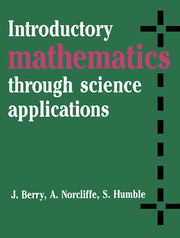Book contents
- Frontmatter
- Contents
- Preface
- 1 Basic functions
- 2 Functions for science 1: the exponential function
- 3 Functions for science 2: trigonometric functions
- 4 Functions for science 3: inverse functions
- 5 Other functions of science
- 6 Differentiation 1: rates of change
- 7 Differentiation 2: stationary points
- 8 Differentiation 3: approximation of functions
- 9 Integration 1: introduction and standard forms
- 10 Integration 2: techniques of integration
- 11 Integration 3: further techniques
- 12 First-order ordinary differential equations
- 13 Second-order ordinary differential equations
- 14 Statistics 1: frequency distributions and associated measures
- 15 Statistics 2: probability and probability distributions
- 16 Statistics 3: sampling, sampling distributions and hypothesis testing
- 17 Partial differentiation 1: introduction
- 18 Partial differentiation 2: stationary points
- Answers to the exercises
- Index
3 - Functions for science 2: trigonometric functions
Published online by Cambridge University Press: 05 June 2012
- Frontmatter
- Contents
- Preface
- 1 Basic functions
- 2 Functions for science 1: the exponential function
- 3 Functions for science 2: trigonometric functions
- 4 Functions for science 3: inverse functions
- 5 Other functions of science
- 6 Differentiation 1: rates of change
- 7 Differentiation 2: stationary points
- 8 Differentiation 3: approximation of functions
- 9 Integration 1: introduction and standard forms
- 10 Integration 2: techniques of integration
- 11 Integration 3: further techniques
- 12 First-order ordinary differential equations
- 13 Second-order ordinary differential equations
- 14 Statistics 1: frequency distributions and associated measures
- 15 Statistics 2: probability and probability distributions
- 16 Statistics 3: sampling, sampling distributions and hypothesis testing
- 17 Partial differentiation 1: introduction
- 18 Partial differentiation 2: stationary points
- Answers to the exercises
- Index
Summary
Scientific context
Example 1: A swinging pendulum. The photograph in Fig. 3.1 shows the motion of a swinging pendulum. The multiple images of the pendulum, obtained using stroboscopic lighting, represent its position at the times when the stroboscope flashed which was every tenth of a second. In Fig. 3.2 we have drawn a graph of the horizontal displacement of the pendulum bob from its central position (i.e. when the string is vertical).
None of the functions we have considered so far provides a model for the way the displacement changes with time and this is obvious if we draw the graph of the displacement over a much longer time interval. This graph is shown in Fig. 3.3. As the bob swings backwards and forwards its displacement varies from – 0.076 m to + 0.076 m in a periodic way.
Polynomials and exponential functions are not periodic and so it is clear that a new class of functions is going to be needed if we are to describe the kind of motion shown. This wave-type behaviour is a very common feature of many periodic systems in science.
Question: What kinds of system and physical phenomena exhibit this behaviour?
Answer: Systems giving rise to waves are obvious candidates. A stretched string that is plucked, waves on water, the motions of tides and planets, light waves, radio waves, alternating currents in electricity, are all examples of wave motion. […]
- Type
- Chapter
- Information
- Introductory Mathematics through Science Applications , pp. 66 - 100Publisher: Cambridge University PressPrint publication year: 1989

